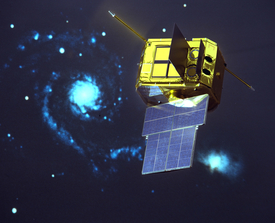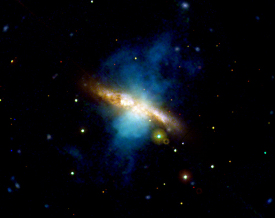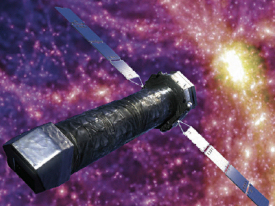History of X-ray Astronomy in Europe: From EXOSAT to Athena
EXOSAT, Europe's pioneer X-ray mission
X-ray astronomy began in 1948 with the detection of X-ray emission from the hot corona of the Sun. But it was not until 1962 that this branch of astronomy started in earnest, with the discovery of the first X-ray source outside of our Solar System. A US team led by Riccardo Giacconi – who received the Nobel Prize in Physics in 2002 for the discovery – detected X-rays from Scorpius X-1 (the first X-ray source in the Scorpius constellation) using a detector on-board a sounding rocket. The mysteriously powerful X-ray emission from this object, and the possibility of discovering more bright X-ray sources like it, led to the launch of a number of other X-ray detectors on rocket flights, with efforts being led mainly by teams in the US and UK.
This first period marked by sounding rockets gave way to a new chapter in this history, with instruments flown on satellites. This was inaugurated by NASA's Uhuru, the first satellite dedicated to X-ray astronomy, launched in 1970 from the Italian San Marco platform off the coast of Kenya. More satellites followed throughout the 1970s, led by teams and agencies in the US, UK, Netherlands and Japan.
 |
| EXOSAT. Credit: ESA |
With a flurry of discoveries of bright X-ray sources during the 1960s, interest in building and launching a European X-ray satellite had been growing. Between 1967 and 1969, two X-ray missions were proposed to the European Space Research Organisation (ESRO), one of the two organisations that later merged to form ESA. One of the proposals was the Highly Eccentric Lunar Occultation Satellite, or Helos, which aimed at pinpointing the location of bright X-ray sources and identifying the mysterious objects responsible for the powerful X-ray radiation. The mission was approved in 1973, but only launched 10 years later – with changes to the original mission concept – under the name EXOSAT, the European X-ray Observatory Satellite.
EXOSAT was a pioneering mission in many ways. It was the first ESA mission designed to study the X-ray universe and one of the first uncrewed satellites to carry an on-board computer. It made several ground-breaking scientific discoveries. These included the detection of a flickering about specific frequencies in the X-ray emission of certain low-mass binary stars – a phenomenon dubbed quasi-periodic oscillations – and the observation of rapidly varying emission from several active galaxies, recognised as the first strong evidence for the presence of a supermassive black hole at their core. At the end of its three-year life, EXOSAT had made close to 1800 observations of X-rays from cosmic objects ranging from supernova remnants to active galactic nuclei.
"The EXOSAT heritage is also seen in the modern practice of operating astronomy missions as international, competitive, open-access observatories. The operational and user support for EXOSAT was, in my own experience, on a different level to any previous space project," says Ken Pounds, Emeritus Professor of Physics at the University of Leicester, who had previously worked with Giacconi on several NASA missions.
"With hindsight, the challenge of developing a competitive X-ray astronomy mission in an era when a better-resourced NASA programme set the space science agenda was – for me, and no doubt others – a strong influence in later arguing for ESA to set out its own long-term priorities. The outcome was Horizon 2000, of course, with XMM-Newton – a very worthy successor to EXOSAT – as one of four Cornerstone Missions."
The path to XMM-Newton, a world-class observatory
In the years between the end of EXOSAT operations, in 1986, and the launch of XMM-Newton – ESA's X-ray Multi-Mirror Mission named after Isaac Newton – in 1999, other European space institutes made great strides in X-ray astronomy.
The Max Planck Institute for Extraterrestrial Research in Germany is the birthplace of ROSAT (Röntgensatellit), a German Aerospace Center-led mission launched in 1990 in cooperation with NASA and the British Science and Engineering Research Council. At the time of its launch, ROSAT carried the largest imaging X-ray telescope ever put into orbit. The mission was designed to perform an all-sky survey in X-rays and, by the end of its 8-year lifespan, ROSAT had detected over 80,000 X-ray objects, some of which were the target of detailed follow-up observations. The observation and study of hot gas clouds in galaxy clusters and the finding of X-ray emission from comets are some of ROSAT's scientific highlights.
Another European X-ray mission was launched in 1996: BeppoSAX, a satellite of the Italian Space Agency with participation from the Netherlands Agency for Aerospace Programmes and contributions from a number of Italian scientific institutes, the Netherlands Institute for Space Research (SRON), and ESA. Named after Giuseppe (Beppo) Occhialini, BeppoSAX discovered the X-ray afterglow of gamma-ray bursts, which are some of the most energetic explosions in the cosmos.
 |
| Galaxy M82 imaged by XMM-Newton. Credit: ESA |
The two outstanding missions in the history of X-ray astronomy were launched just three years later: NASA's Chandra X-ray Observatory in July 1999, and ESA's XMM-Newton in December of the same year. Both are equipped with X-ray cameras and spectrometers, and have strongly complementary capabilities. The Chandra optics and instruments have a very high angular resolution, whilst those on board XMM-Newton have a higher effective area and a greater field of view, enabling extremely sensitive observations and surveys that span large areas of the sky. XMM-Newton was the biggest science satellite ever built in Europe.
"One of the strongest points of XMM-Newton is the fact that all six instruments observe simultaneously and therefore provide a unique set of images and spectra, which have often led to new and unexpected breakthroughs," says Norbert Schartel, ESA's Project Scientist for XMM-Newton.
Nearly 20 years later, both Chandra and XMM-Newton are still operational, greatly expanding their planned mission lifetimes of 5 and 10 years, respectively.
With these two powerful X-ray missions, their sensitive cameras and complementary instruments in operation at the same time, astronomers are enjoying a golden era of X-ray astronomy, featuring a wealth of important scientific observations. Among many highlights, these observatories have made it possible to detect giant flares from young stars, to show how rotating black holes drag space-time around them, and to provide an independent way to measure the accelerated expansion of the Universe by observing the X-ray emitting, hot gas that permeates galaxy clusters.
Staying on top: the road to Athena
The quest to understand the X-ray sky continues into the 21st century, with new international partners joining this exciting endeavour. In particular, the Japanese Aerospace Exploration Agency (JAXA) has launched a number of important X-ray missions.
The most recent was Hitomi, an X-ray observatory carrying a new type of spectrometer that can measure the temperature, density, and velocity of astrophysical plasma under a wide range of conditions with unprecedented precision thanks to much improved spectral resolution. An international collaboration with contributions from the US, Canada, and Europe, Hitomi was launched in 2016 but was unfortunately lost after only six weeks of operations due to an anomaly of the attitude control system. Nevertheless, the few observations performed in this short time allowed astronomers to make breakthrough discoveries on the dynamics and the metallicity of the hot gas permeating galaxy clusters.
The exciting results of Hitomi led JAXA and NASA to agree on a new mission, the X-Ray Imaging and Spectroscopy Mission (XRISM), which is planned for launch in the early 2020s and also involves participation by ESA and European research institutions. XRISM aims to perform high-resolution X-ray spectroscopy of galaxy clusters, accreting black holes, and supernova remnants, amongst other sources, and will serve as an ideal pathfinder to Athena.
 |
| Athena. Credit: The Athena collaboration; background image: Volker Springler/MPA-Chandra/CXC-NASA; Paul Nandra (MPE) |
Athena is ESA's Advanced Telescope for High-ENergy Astrophysics, an X-ray telescope that builds on the legacy of ESA's past X-ray observatories. Due to launch in 2031, Athena will study the Hot and Energetic Universe in synergy with many of the new facilities that will be available in the 2030s such as the Square Kilometre Array (SKA), ESO's Extremely Large Telescope (ELT), and LISA, ESA's Laser Interferometer Space Antenna, which will be the first space-based gravitational wave observatory. Together these facilities promise to once again revolutionise our understanding of the cosmos.
The mission will concentrate on two of the key questions in astrophysics today: how do black holes grow and shape the galaxies around them, and how does 'ordinary' or baryonic matter assemble into the large-scale cosmic structures built by the mysterious dark matter? Athena will have the sensitivity to study the properties of black holes back in time to the 'epoch of reionisation', when the first stars and galaxies were taking shape, allowing astronomers to probe the seeds of the supermassive black holes we observe at the centre of most galaxies in the local Universe. It will also investigate the assembly of the largest structures in the Universe using its extraordinary spectral resolution and sensitivity to observe the motion, composition and temperature of the hot gas within and between clusters of galaxies, which is where most of the ordinary matter in the Universe resides.
"Athena will provide a giant leap in scientific performance. New developments in X-ray optics and a new generation of cryogenic X-ray detectors will enable Athena's capabilities to far exceed even those of XMM-Newton," says Matteo Guainazzi, Athena Study Scientist at ESA.
"However, above all Athena will be an observatory. The large majority of its observing time will be open to the astronomical community worldwide through a competitive peer review process. The short but intense history of X-ray astronomy shows that there is no telling what new, unexpected scientific discoveries a powerful new observatory with unprecedented capabilities will unveil."
